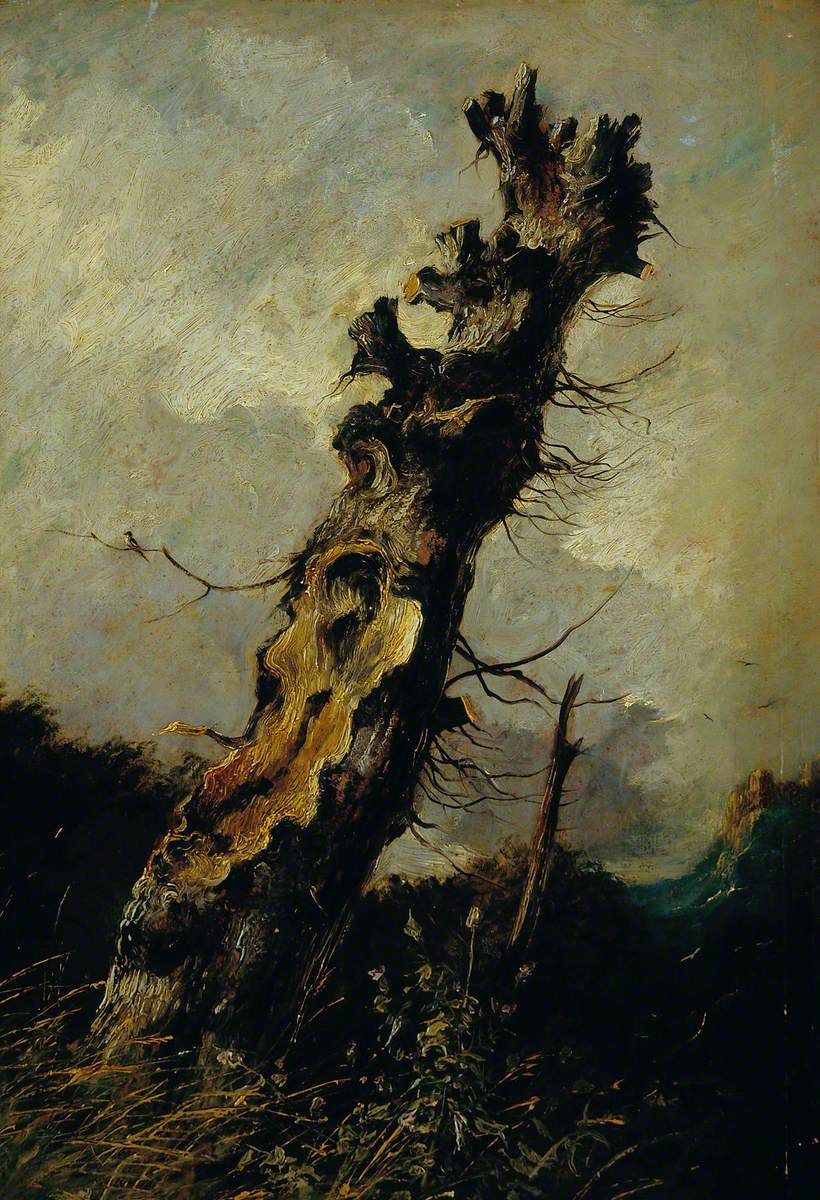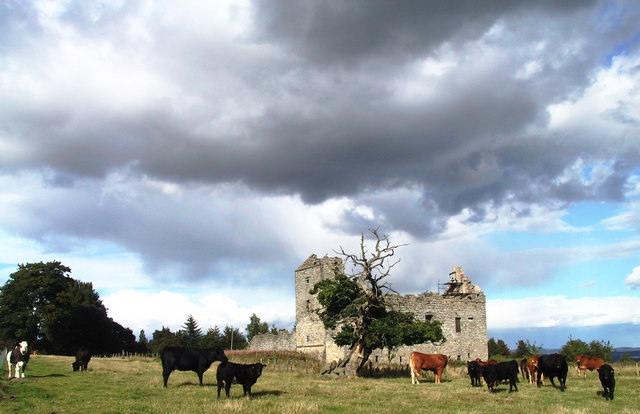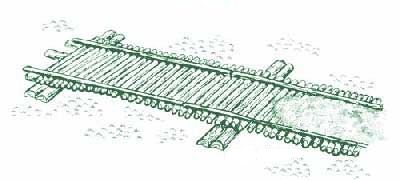|
Wallace Oak (Torwood)
The Wallace Oak was a tree in Torwood, Scotland. it is thought to have been part of the Torwood ancient woodland and has been linked to pre-Christian druidic worship. The tree became associated with the Scottish independence leader William Wallace. Its hollow trunk is reputed to have served him as a headquarters, hiding place and sleeping quarters. By the 17th century the tree was being used to make souvenirs due to its association with Wallace. By 1830 it was described as badly affected by the removal of timber, being reduced to a single stump. Timber being scarce above ground its roots were also dug up for souvenirs and the tree was dead by 1835. Association with Wallace The tree stood in the ancient forest of Torwood and is reputed to have been the focus of druidic worship in ancient times. The writer John Donald Carrick in the early 19th-century described the tree as having "greater antiquity" than any tree he had seen in Scotland. The tree stood on a raised plat ... [...More Info...] [...Related Items...] OR: [Wikipedia] [Google] [Baidu] |
Torwood
Torwood ( gd, Coille Tor) is a small village located north-northwest of Larbert, north-west of Falkirk and south-southeast of Stirling. Torwood lies within the Falkirk Council area of Scotland. The population recorded in the 2011 UK Census was 245. The A9 road between Bannockburn and Camelon runs through the village. Torwood Has 3 streets: Castle Crescent, Forester Gait & Glen Road. Glen Road leads on to Torwood Castle, Quarry and Broch. History The Forresters used to own the lands of Torwood and Torwood Castle but now a private trust owns the castle. Forrester Gait was named after the family. The Torwood was a large forested area in the 12th century stretching from the River Carron west and north towards Stirling, and inland towards the Campsie Hills. It was traversed by an old Roman Road at this time. In preparation for the Battle of Bannockburn it was used as the encampment for the men of Sir James Douglas, one of the leaders of the army of King Robert the Bruce ... [...More Info...] [...Related Items...] OR: [Wikipedia] [Google] [Baidu] |
Scottish Exhibition Of National History, Art And Industry
The Scottish Exhibition of National History, Art and Industry was held in Glasgow in 1911. It was the third of 4 international exhibitions held in Glasgow, Scotland during the late 19th and early 20th centuries. Summary The exhibition followed the lead of the previous two exhibitions ( Glaswegian exhibition (1888) and Glasgow International Exhibition (1901)) and took place at Kelvingrove Park. It ran from 2 May to 4 November 1911, and recorded over 9.3 million visits. The aim of the event was to fund a Chair of Scottish History and Literature at the University of Glasgow, with the Exhibition Prospectus quoting the resolution of a March 1909 meeting: ''"the time had fully arrived when Scottish history should be placed on a differing plane from that which it had hitherto occupied in the education of the rising generations."'' Although the size of this National exhibition was largely similar to that of its International predecessors, it garnered little attention from the London- ... [...More Info...] [...Related Items...] OR: [Wikipedia] [Google] [Baidu] |
Individual Trees In Scotland
An individual is that which exists as a distinct entity. Individuality (or self-hood) is the state or quality of being an individual; particularly (in the case of humans) of being a person unique from other people and possessing one's own needs or goals, rights and responsibilities. The concept of an individual features in diverse fields, including biology, law, and philosophy. Etymology From the 15th century and earlier (and also today within the fields of statistics and metaphysics) ''individual'' meant " indivisible", typically describing any numerically singular thing, but sometimes meaning "a person". From the 17th century on, ''individual'' has indicated separateness, as in individualism. Law Although individuality and individualism are commonly considered to mature with age/time and experience/wealth, a sane adult human being is usually considered by the state as an "individual person" in law, even if the person denies individual culpability ("I followed instruct ... [...More Info...] [...Related Items...] OR: [Wikipedia] [Google] [Baidu] |
Corduroy Road
A corduroy road or log road is a type of road or timber trackway made by placing logs, perpendicular to the direction of the road over a low or swampy area. The result is an improvement over impassable mud or dirt roads, yet rough in the best of conditions and a hazard to horses due to shifting loose logs. Corduroy roads can also be built as a foundation for other surfacing. If the logs are buried in wet, acidic, anaerobic soils such as peat or muskeg, they decay very slowly. A few corduroy road foundations that date back to the early 20th century still exist in North America. One example is the Alaska Highway between Burwash Landing and Koidern, Yukon, Canada, which was rebuilt in 1943, less than a year after the original route was graded on thin soil and vegetation over permafrost, by using corduroy, then building a gravel road on top. During the 1980s, the gravel was covered with a chip-seal. The late 1990s saw replacement of this road with modern road construction, ... [...More Info...] [...Related Items...] OR: [Wikipedia] [Google] [Baidu] |
George IV Of The United Kingdom
George IV (George Augustus Frederick; 12 August 1762 – 26 June 1830) was King of the United Kingdom of Great Britain and Ireland and King of Hanover from the death of his father, King George III, on 29 January 1820, until his own death ten years later. At the time of his accession to the throne, he was acting as Prince Regent, having done so since 5 February 1811, during his father's final mental illness. George IV was the eldest child of King George III and Queen Charlotte. He led an extravagant lifestyle that contributed to the fashions of the Regency era. He was a patron of new forms of leisure, style and taste. He commissioned John Nash to build the Royal Pavilion in Brighton and remodel Buckingham Palace, and commissioned Jeffry Wyatville to rebuild Windsor Castle. George's charm and culture earned him the title "the first gentleman of England", but his dissolute way of life and poor relationships with his parents and his wife, Caroline of Brunswick, earned him t ... [...More Info...] [...Related Items...] OR: [Wikipedia] [Google] [Baidu] |
John Thomson Of Duddingston
Rev John Thomson FRSE Hon RSA (1 September 177828 October 1840) was a Scottish minister of the Church of Scotland and noted amateur landscape painter. He was the minister of Duddingston Kirk from 1805 to 1840. Life The youngest of eight children, Thomson was born in the manse at Dailly, Ayrshire, the fourth son of Mary Hay and her husband, Rev Thomas Thomson, the local parish minister of the Church of Scotland. He was educated at Dailly Parish School. From an early age, he displayed an aptitude for drawing and painting and, inspired by the Ayrshire countryside, developed a love for landscape painting. In 1791 he enrolled at the University of Glasgow to study law and theology, and in 1793 he transferred to the University of Edinburgh to study divinity. While there, he met many people who were prominent in Edinburgh artistic circles, including Walter Scott, and Alexander Nasmyth, the latter of whom who gave him art lessons. After graduating, Thomson returned to Ayrshire and ... [...More Info...] [...Related Items...] OR: [Wikipedia] [Google] [Baidu] |
George Washington
George Washington (February 22, 1732, 1799) was an American military officer, statesman, and Founding Father who served as the first president of the United States from 1789 to 1797. Appointed by the Continental Congress as commander of the Continental Army, Washington led the Patriot forces to victory in the American Revolutionary War and served as the president of the Constitutional Convention of 1787, which created the Constitution of the United States and the American federal government. Washington has been called the " Father of his Country" for his manifold leadership in the formative days of the country. Washington's first public office was serving as the official surveyor of Culpeper County, Virginia, from 1749 to 1750. Subsequently, he received his first military training (as well as a command with the Virginia Regiment) during the French and Indian War. He was later elected to the Virginia House of Burgesses and was named a delegate to the Continental Congress ... [...More Info...] [...Related Items...] OR: [Wikipedia] [Google] [Baidu] |
David Erskine, 11th Earl Of Buchan
David (; , "beloved one") (traditional spelling), , ''Dāwūd''; grc-koi, Δαυΐδ, Dauíd; la, Davidus, David; gez , ዳዊት, ''Dawit''; xcl, Դաւիթ, ''Dawitʿ''; cu, Давíдъ, ''Davidŭ''; possibly meaning "beloved one". was, according to the Hebrew Bible, the third king of the United Kingdom of Israel. In the Books of Samuel, he is described as a young shepherd and harpist who gains fame by slaying Goliath, a champion of the Philistines, in southern Canaan. David becomes a favourite of Saul, the first king of Israel; he also forges a notably close friendship with Jonathan, a son of Saul. However, under the paranoia that David is seeking to usurp the throne, Saul attempts to kill David, forcing the latter to go into hiding and effectively operate as a fugitive for several years. After Saul and Jonathan are both killed in battle against the Philistines, a 30-year-old David is anointed king over all of Israel and Judah. Following his rise to power, David ... [...More Info...] [...Related Items...] OR: [Wikipedia] [Google] [Baidu] |
Alexander Nasmyth
Alexander is a male given name. The most prominent bearer of the name is Alexander the Great, the king of the Ancient Greek kingdom of Macedonia (ancient kingdom), Macedonia who created one of the largest empires in ancient history. Variants listed here are Aleksandar, Aleksander and Aleksandr. Related names and diminutives include Iskandar, Alec, Alek, Alex, Alexandre (given name), Alexandre, Aleks (given name), Aleks, Aleksa (given name), Aleksa and Sander (name), Sander; feminine forms include Alexandra, Alexandria (given name), Alexandria, and Sasha (name), Sasha. Etymology The name ''Alexander'' originates from the (; 'defending men' or 'protector of men'). It is a compound of the verb (; 'to ward off, avert, defend') and the noun (, genetive, genitive: , ; meaning 'man'). It is an example of the widespread motif of Greek names expressing "battle-prowess", in this case the ability to withstand or push back an enemy shield wall, battle line. The earliest Attested langua ... [...More Info...] [...Related Items...] OR: [Wikipedia] [Google] [Baidu] |
Charles Cochrane-Baillie, 2nd Baron Lamington
Charles Wallace Alexander Napier Cochrane-Baillie, 2nd Baron Lamington, (29 July 1860 – 16 September 1940), was a British politician and colonial administrator who served as Governor of Queensland from 1896 to 1901, and Governor of Bombay from 1903 to 1907. Early life Born in London, England, he was the only son of Alexander Baillie-Cochrane, 1st Baron Lamington. Charles was educated at Eton College and Christ Church, Oxford, where he graduated with a Bachelor of Arts in 1883. In 1885, he became assistant private secretary to the Prime Minister of the United Kingdom, Lord Salisbury.R. B. Joyce'Lamington, second Baron (1860–1940)' ''Australian Dictionary of Biography'', Volume 9, Melbourne University Press, 1983, pp. 653–654. Political career Cochrane-Baillie was narrowly defeated in the 1885 election for the borough constituency of St Pancras North, but he won the subsequent election in July 1886, taking his seat in the British House of Commons for the Conserva ... [...More Info...] [...Related Items...] OR: [Wikipedia] [Google] [Baidu] |
Woodland
A woodland () is, in the broad sense, land covered with trees, or in a narrow sense, synonymous with wood (or in the U.S., the ''plurale tantum'' woods), a low-density forest forming open habitats with plenty of sunlight and limited shade (see differences between British, American, and Australian English explained below). Woodlands may support an understory of shrubs and herbaceous plants including grasses. Woodland may form a transition to shrubland under drier conditions or during early stages of primary or secondary succession. Higher-density areas of trees with a largely closed canopy that provides extensive and nearly continuous shade are often referred to as forests. Extensive efforts by conservationist groups have been made to preserve woodlands from urbanization and agriculture. For example, the woodlands of Northwest Indiana have been preserved as part of the Indiana Dunes. Definitions United Kingdom ''Woodland'' is used in British woodland management to mean tre ... [...More Info...] [...Related Items...] OR: [Wikipedia] [Google] [Baidu] |
Quaich
A quaich , archaically quaigh or quoich, is a special kind of shallow two-handled drinking cup or bowl of a type traditional in Scotland. It derives from the Scottish Gaelic (), meaning a cup. History According to the 1911 ''Encyclopædia Britannica'', the quaich was inspired by the low silver bowls with two flat handles frequently used as bleeding vessels in England and the Netherlands in the 17th century. Another popular theory suggests that the shape is derived from scallop shells. However, this seems to have had its origins in the poems of James Macpherson which were once thought to be translations of poems by Ossian, son of Fionn mac Cumhaill. In his 1955 monograph ''Some Scottish Quaichs'', Richard L. McClenahan, an American collector, suggests that the quaich evolved directly from the medieval mazer. This seems unlikely as the form and material (burr maple for mazers) are quite different. There were small stave-built drinking vessels common in the medieval period fo ... [...More Info...] [...Related Items...] OR: [Wikipedia] [Google] [Baidu] |









